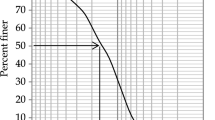Abstract
Fly ash-lime-phosphogypsum (FaL-G) bricks are one of the best alternatives to the conventional burnt clay bricks. This paper gives the results of an experimental investigation in which the compressive strength, water absorption, density and durability of Fly ash-lime-phosphogypsum (FaL-G) bricks were investigated by using varying quantities of fly ash, lime and calcined phosphogypsum. The properties of Fly ash-lime-phosphogypsum (FaL-G) bricks are compared with those of the ordinary burnt clay bricks. The results indicate that these bricks are lighter in weight, durable in aggressive environments and have sufficient strength for their use in building construction.
Résumé
Les briques à base de cendres volantes-chaux-phosphogypse (FaL-G) sont une des meilleures alternatives aux briques conventionnelles en terre cuite. Cet article présente les résultats d'une étude expérimentale dans laquelle la résistance à la compression, l'absorption d'eau, la densité et la durabilité des briques en FaL-G ont été examinées en utilisant différentes quantités de cendres volantes, de chaux et de phosphogypse calciné. Les propriétés des briques en FaL-G sont comparées avec celles des briques ordinaires en terre cuite. Les résultats obtenus indiquent que ces briques sont plus légères, durables dans des environnement agressifs et assez résistantes pour être utilisées dans la construction.
Similar content being viewed by others
References
Verma, C. L., Handa, S. K., Jain, S. K. and Yadav, R. K., ‘Techno-commercial perspective study for sintered fly ash light weight aggregates in India’,Construction and Building Materials,12 (1988) 341–346.
Singh, M. and Garg, M., ‘Durability of cementitious binder derived from industrial wastes’,Mater. Struct.,30 (December 1997) 607–612.
Ouyang, C., Nanni, A. and Wen F. Cheng, ‘Internal and external sources of sulfate ions in Portland cement mortar: two types of chemical attack’,Cement and Concrete Research 18 (5) (1988) 699–709.
Valenti, G. L., Cioffi, R., Santoro, L. and Ranchetti, S., ‘Influence of chemical and physical properties of Italian fly ashes on reactivity towards lime, phosphogypsum and water’,Cement and Concrete Research 18 (1) (1988) 91–102.
Bhanumathidas, N. and Kalidas, N., ‘New trend in bricks and blocks: the role of FaL-G’,The Indian Concrete Journal 66 (1992) 389–392.
Singh, M. and Garg, M., ‘Phosphogypsum, fly ash cementitious binder-its hydration and strength development’,Cement and Concrete Research 25 (4) (1995) 752–758.
Garg, M., Singh, M. and Kumar, R., ‘Some aspects of the durability of a phosphogypsum-lime-fly ash binder’,Construction and Building Materials 10 (1996) 273–279.
Singh, L. P., ‘Investigation of physical properties of bricks utilizing fly ash, lime and gypsum’, M. Tech Dissertation, Kanpur University, Kanpur, India, 1994.
Ambalavanan, R. and Roja, A., ‘Feasibility study on utilization of waste lime and gypsum with fly ash’,The Indian Concrete Journal 70 (11) (1996) 611–616.
Kumar, S. and Singh, L. P., ‘Utilization of FaL-G bricks in low cost housing’, in ‘Environmental Aspects of Engineering Practices’, Proceedings of a National Seminar, Jhansi, India, April 1998.
Indian Standard, IS: 1077, ‘Specification for common burnt clay building bricks’, Bureau of Indian Standards, New Delhi, India, 1986.
Author information
Authors and Affiliations
Rights and permissions
About this article
Cite this article
Kumar, S. Fly ash-lime-phosphogypsum cementitious binder: A new trend in bricks. Mat. Struct. 33, 59–64 (2000). https://doi.org/10.1007/BF02481697
Received:
Accepted:
Issue Date:
DOI: https://doi.org/10.1007/BF02481697




